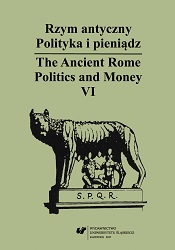U północnych wrót Bramy Morawskiej. Stan badań nad znaleziskami monet rzymskich
na ziemi głubczyckiej i raciborskiej 1945—2013
AT THE NORTHERN ENTRANCE OF THE MORAVIAN GATE: THE STATE OF RESEARCH ON FINDINGS OF ROMAN COINS IN THE GŁUBCZYCE AND RACIBÓRZ LANDS IN THE YEARS 1945—2013
Author(s): Dariusz Chojecki
Subject(s): History
Published by: Wydawnictwo Uniwersytetu Śląskiego
Summary/Abstract: The Głubczyce-Racibórz land, that is, the titular “northern entrance” of the Moravian Gate, is an area of the most numerous findings of the Roman coins north of Danube. First mentions regarding the land appear in the literature on the subject as early as at the beginning of the nineteenth century. In the present article the author discusses the state of the research on the said findings, focusing mainly on the years 1945—2013. While the mentioned period remains his main point of reference, archival materials and scholarly publications from the nineteenth and the first half of twentieth century are analysed as well.Starting his survey of relevant publications, the author provides information on the work byMajewski, Fenyn and Konik of the year 1949, and next he proceeds to later studies by Polishresearchers (Gumowski, Wielowiejski, Szydłowski, Kunisz, Burszche, Łonak, Dymowski, Ciołek, and a few of his own works). He devotes more attention to studies by Eugeniusz Konik from 1965 and Kazimierz Godłowski from 1973. Since the second half of the twentieth century appears to be a time of negligible findings of Roman coins in the discussed area, the researchers virtually confine their remarks to meticulous analysis of archival sources and previous studies performed by German numismatists. Wasn’t there in fact any noteworthy coin findings made at this time? This supposition may strike as rather absurd considering the previously-made discoveries. A German periodical Altschlesische Blätter, in the period 1927—1942 alone, as much as 48 times announced the discoveries of Roman coins, both single and multiple, made in the Głubczyce-Racibórz land. In a village of Nowa Cerekwia alone, in the period from the late eighteenth century to the half of the twentieth century, the researchers recorded 150 numismatic artefacts. Therefore, there is no slightest doubt that some Roman coins were unearthed also in the second half of the twentieth century; the information about them, however, did not escape the small circle of finders, and this, in turn, prevented the findings from being recorded in the literature. Not until the beginning of the twenty-first century did the situation change. The author of the article discusses the reports on the new discoveries of Roman coins in the area of interest, prepared by Arkadiusz Dymowski, that have appeared in the literature on the subject. He also turns the readers’ attention towards new studies of the Roman coins discoveries in Silesia, namely works by Wojciech Łonak and Renata Ciołek.Part two of the article was not based on literature, but instead it concerns previously unannounced findings. Presently, the coins are discovered that are later included into public collections. The Racibórz Museum in 2002 has acquired 12 copper Roman coins, in 2008 in a village of Nędza 7 copper Roman coins have been found along with an Alexander Jannaeus prutah. The said museum has also come into possession of an Antoninus Pius denar unearthed during excavation works in Tworków.In 2001, the Poviat Museum of Głubczyce Land is established. A year later the institutionacquires 9 fourth-century coins coming from Lower Silesia and a Trajan denar unearthed inPiotrowice Głubczyckie. Also, the single Roman coin discovered among the treasure consisting of republican coins in 2010 is added to the Museum’s collection. Currently, this institution is in possession of 11 Roman coins found in the area of Silesia. In addition, the Museum of Opole Silesia has come into possession of numismatic items found upon excavations currently taking place at the archaeological site in Nowa Cerekwia.The coins are found as a result of archaeological works carried out, but also discoveredcoincidentally, or they are unearthed during pre-planned “treasure hunting” events. While archaeologist obviously hand their discoveries over to museums, the remaining two types of finders are not always keen to do it. The treasure of coins from Nędza has been included into the Racibórz museum’s collection, whereas the coins from Nowa Wieś Głubczycka have been almost entire dispersed. The latter is considered to be an extremely important finding, since republican coins have been hitherto extraordinarily rare in Silesia. It may have seemed that in the area in question we would deal only with Celtic or Roman imperial coins. However, the treasure from Nowa Wieś Głubczycka along with findings of the years 2007—2008 in Racibórz, Raków, and Księże Pole, clearly indicate the need to investigate the inflow of Roman coins on Głubczyce-Racibórz land more closely, which also applies to the area of the entire Silesia.
Book: Rzym antyczny. Polityka i pieniądz / The Ancient Rome. Politics and Money. T. 6
- Page Range: 61-73
- Page Count: 13
- Publication Year: 2017
- Language: Polish
- Content File-PDF

